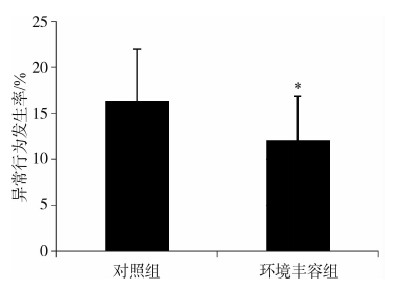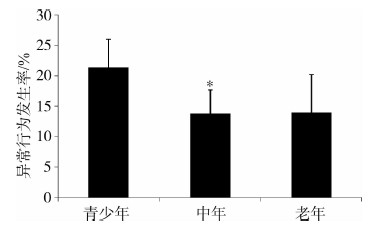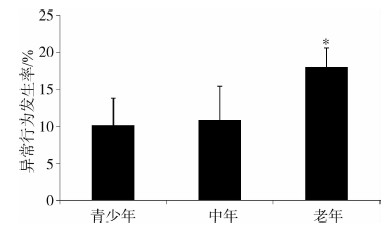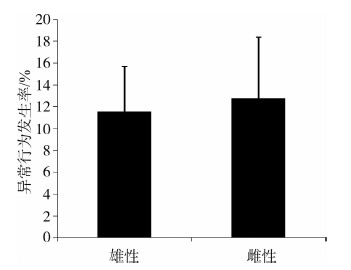扩展功能
文章信息
- 高建峰, 滕利, 郭铭, 周立, 包容, 饶艳, 杨四军, 霍文哲
- GAO Jianfeng, TENG Li, GUO Ming, ZHOU Li, BAO Rong, RAO Yan, YANG Sijun, HUO Wenzhe
- 环境丰容对长期单笼圈养食蟹猴行为的影响
- Effects of Environmental Enrichment on the Behaviors of Long-term Individually-caged Cynomolgus Macaques
- 四川动物, 2016, 35(): 243-248
- Sichuan Journal of Zoology, 2016, 35(): 243-248
- 10.11984/j.issn.1000-7083.20150243
-
文章历史
- 收稿日期: 2015-08-08
- 接受日期: 2015-11-21
2. 武汉市妇女儿童医疗保健中心病理科, 武汉 430016
2. Department of Pathology, Wuhan Medical Care Center for Women and Children, Wuhan 430016, China
非人灵长类实验动物福利状况越来越成为关注的问题(Meade et al. ,2014)。其中,行为异常在人工圈养非人灵长类实验动物中十分常见(Baker et al. ,2009;Sommanustweechai et al.,2013;Wallace et al.,2013),原因可能是其进化程度更高和群居性更强(Márquez-Arias et al. ,2010)。圈养非人灵长类实验动物频繁出现刻板活动或自伤行为时,就意味着动物福利和研究数据的可靠性等问题随之产生(Bellanca & Crockett,2002)。由于科学研究中基本是以人类为中心的观念,导致动物福利一直是个很有争议的话题(Chamove,1989)。实际上,动物不同的应激程度可以通过行为学或皮质醇的水平来监测(Suzuki et al.,2002;Suleman et al.,2004)。以往的研究已能鉴别出正常或适宜的动物行为,如觅食和玩耍活动,以及异常或不适宜的活动,如刻板活动、嗜粪癖和过度的攻击行为(Brüne et al.,2006)。本研究中动物福利的界定主要是异常行为,如吮指(趾)、刻板活动、攻击行为和嗜粪癖等发生率的下降,以及在野外常见的觅食和玩耍活动增多。圈养动物没有能力改变生活环境,只能被动地去适应,异常行为的发生率会大幅增加,而通过有计划地改善环境,如给予镜子、玩具、音效等感官刺激,可以明显改变这种状况(Bloomsmith & Lambeth,2000;Olsson et al.,2003)。此外,群居环境,包括与同种动物的视觉、触觉和气味接触对圈养动物同样重要(Wojciechowski,2004)。本研究旨在评估环境丰容对长期单笼圈养食蟹猴行为的影响,以期为进一步研究生活环境对非人灵长类实验动物身心健康影响的生理学机制提供理论依据和实验参考。
1 材料与方法 1.1 材料 1.1.1 实验动物选用不同年龄段的食蟹猴30只,雌雄各半(表 1),饲养在实验室单笼内。自由采食、饮水,每天光照12 h,温度控制在20 ℃~24 ℃,相对湿度55% ~65%,实验开始前进行7 d适应性饲养。
| 动物序号 | 年龄分布 | 性别 |
| 1 | 青少年 | 雄性 |
| 2 | 青少年 | 雄性 |
| 3 | 青少年 | 雄性 |
| 4 | 青少年 | 雄性 |
| 5 | 青少年 | 雄性 |
| 6 | 青少年 | 雌性 |
| 7 | 青少年 | 雌性 |
| 8 | 青少年 | 雌性 |
| 9 | 青少年 | 雌性 |
| 10 | 青少年 | 雌性 |
| 11 | 中年 | 雄性 |
| 12 | 中年 | 雄性 |
| 13 | 中年 | 雄性 |
| 14 | 中年 | 雄性 |
| 15 | 中年 | 雄性 |
| 16 | 中年 | 雄性 |
| 17 | 中年 | 雄性 |
| 18 | 中年 | 雌性 |
| 19 | 中年 | 雌性 |
| 20 | 中年 | 雌性 |
| 21 | 中年 | 雌性 |
| 22 | 中年 | 雌性 |
| 23 | 中年 | 雌性 |
| 24 | 中年 | 雌性 |
| 25 | 老年 | 雄性 |
| 26 | 老年 | 雄性 |
| 27 | 老年 | 雄性 |
| 28 | 老年 | 雌性 |
| 29 | 老年 | 雌性 |
| 30 | 老年 | 雌性 |
所有单体猴笼均采用不锈钢网制成,规格为0.7 m×0.8 m×0.9 m(宽×长×高),符合美国国家学术出版社出版的“Guide for the Care and Use of Laboratory Animals”和中国科技部制定的“实验动物环境及设施”国家标准中关于非人灵长类实验动物单笼尺寸的规定。
1.2 实验方法 1.2.1 实验动物分组实验动物随机均分为对照组(A组,n=15)和环境丰容组(B组,n=15),分别圈养在单笼内。对照组单笼内仅设有食槽和饮水器,面向墙壁;环境丰容组置于另一个房间,单笼内除设有食槽和饮水器外,还有吊环、不锈钢球以及增加采食难度的小石块和塑料瓶,单笼对面设有镜子(猴子能看到自己和邻近的同类),同时间隔播放海水声、雷鸣雨声及鸟叫声等模拟自然音响。
1.2.2 实验周期及观察记录项目实验周期为3个月,期间由固定观察员在不惊扰动物的情况下,分别于上午和下午观察并详细记录每只食蟹猴出现的异常行为,如吸指(趾)、吮生殖器、刻板转圈、踱步、自伤、拔毛癖、嗜粪癖等。
1.3 统计学分析实验数据应用SPSS 17.0进行单因素方差分析;用平均数±标准差表示。P < 0.05表示差异有统计学意义,P < 0.01表示差异有高度统计学意义。
2 结果与分析 2.1 环境丰容对长期单笼圈养食蟹猴异常行为的影响随着时间的延长,2组单笼圈养食蟹猴均出现不同程度的异常行为(表 2),其中,对照组的异常行为发生率明显高于环境丰容组(P < 0.05)(图 1)。
| 分组 | 动物编号 | 吸指(趾) | 吮生殖器 | 刻板转圈 | 踱步 | 自伤 | 拔毛癖 | 嗜粪癖 | 合计 |
| 对照组 | 1 | 8 | 4 | 2 | 2 | 0 | 0 | 0 | 16 |
| 2 | 5 | 2 | 5 | 9 | 0 | 3 | 0 | 24 | |
| 3 | 3 | 2 | 0 | 0 | 0 | 14 | 0 | 19 | |
| 4 | 7 | 2 | 5 | 5 | 0 | 3 | 0 | 22 | |
| 5 | 0 | 0 | 10 | 5 | 2 | 0 | 0 | 17 | |
| 6 | 2 | 0 | 0 | 0 | 4 | 2 | 0 | 8 | |
| 7 | 0 | 0 | 5 | 4 | 0 | 7 | 3 | 19 | |
| 8 | 1 | 4 | 5 | 1 | 0 | 0 | 0 | 11 | |
| 9 | 0 | 0 | 6 | 4 | 2 | 0 | 0 | 12 | |
| 10 | 0 | 4 | 0 | 0 | 0 | 2 | 8 | 14 | |
| 11 | 0 | 0 | 2 | 0 | 1 | 4 | 0 | 7 | |
| 12 | 7 | 3 | 3 | 2 | 1 | 0 | 0 | 16 | |
| 13 | 6 | 0 | 15 | 6 | 0 | 0 | 0 | 27 | |
| 14 | 4 | 0 | 3 | 0 | 3 | 8 | 1 | 19 | |
| 15 | 0 | 0 | 2 | 7 | 4 | 0 | 2 | 15 | |
| 环境丰容组 | 1 | 9 | 0 | 5 | 0 | 0 | 0 | 0 | 14 |
| 2 | 13 | 0 | 0 | 2 | 0 | 1 | 0 | 5 | |
| 3 | 0 | 0 | 0 | 0 | 0 | 7 | 3 | 10 | |
| 4 | 4 | 10 | 0 | 0 | 0 | 0 | 0 | 5 | |
| 5 | 4 | 1 | 0 | 0 | 0 | 8 | 0 | 13 | |
| 6 | 10 | 5 | 0 | 0 | 0 | 0 | 0 | 15 | |
| 7 | 1 | 0 | 14 | 2 | 0 | 0 | 0 | 17 | |
| 8 | 0 | 0 | 0 | 7 | 0 | 14 | 0 | 21 | |
| 9 | 1 | 0 | 2 | 0 | 0 | 6 | 0 | 9 | |
| 10 | 0 | 2 | 0 | 4 | 0 | 4 | 0 | 10 | |
| 11 | 5 | 0 | 2 | 0 | 0 | 10 | 0 | 17 | |
| 12 | 0 | 0 | 5 | 0 | 3 | 0 | 0 | 8 | |
| 13 | 0 | 5 | 0 | 0 | 0 | 0 | 0 | 14 | |
| 14 | 0 | 0 | 6 | 1 | 0 | 0 | 0 | 7 | |
| 15 | 0 | 0 | 0 | 0 | 0 | 3 | 2 | 16 |

|
|
图 1 环境丰容对长期单笼圈养食蟹猴异常行为的影响
Fig. 1 Effects of environmental enrichment on the behaviors of
long-term individually-caged cynomolgus macaques 与对照组相比, * P < 0.05。 Compared with the control group, * P < 0.05. |
| 分组 | 动物序号 | 性别 | 异常行为总数 | |
| 对照组 | 青少年 | 1 | 雌性 | 27 |
| 2 | 雄性 | 19 | ||
| 3 | 雄性 | 22 | ||
| 4 | 雌性 | 24 | ||
| 5 | 雌性 | 15 | ||
| 中年 | 1 | 雄性 | 12 | |
| 2 | 雌性 | 14 | ||
| 3 | 雄性 | 8 | ||
| 4 | 雌性 | 16 | ||
| 5 | 雄性 | 19 | ||
| 6 | 雄性 | 11 | ||
| 7 | 雌性 | 17 | ||
| 老年 | 1 | 雌性 | 16 | |
| 2 | 雌性 | 19 | ||
| 3 | 雄性 | 7 | ||
| 环境丰容组 | 青少年 | 1 | 雌性 | 10 |
| 2 | 雄性 | 13 | ||
| 3 | 雌性 | 5 | ||
| 4 | 雄性 | 14 | ||
| 5 | 雄性 | 9 | ||
| 中年 | 1 | 雌性 | 14 | |
| 2 | 雄性 | 8 | ||
| 3 | 雌性 | 17 | ||
| 4 | 雄性 | 10 | ||
| 5 | 雄性 | 5 | ||
| 6 | 雌性 | 15 | ||
| 7 | 雌性 | 7 | ||
| 老年 | 1 | 雄性 | 16 | |
| 2 | 雌性 | 21 | ||
| 3 | 雄性 | 17 | ||
对照组中,中年食蟹猴异常行为发生率显著低于青少年(P < 0.05),老年与青少年的差异无统计学意义(图 2);环境丰容组中,老年食蟹猴异常行为发生率明显高于青少年(P < 0.05),中年与青少年的差异无统计学意义(图 3)。

|
|
图 2 年龄对对照组长期单笼圈养食蟹猴异常行为的影响
Fig. 2 Effects of age on the abnormal behaviors of
long-term individually-caged cynomolgus macaques in the contrd group
与青少年相比, * P < 0.05; 下图同。 Compared with the juveniles, * P < 0.05; the same below. |

|
| 图 3 年龄对环境丰容组长期单笼圈养食蟹猴异常行为的影响 Fig. 3 Effects of age on the abnormal behaviors of long-term individually-caged cynomolgus macaques in the environmental enrichment group |
对照组中,性别对青少年、中年和老年异常行为的发生率没有显著影响(图 4);与之相似,性别对环境丰容组3个年龄段的异常行为发生率也没有明显影响(图 5)。

|
| 图 4 性别对对照组长期单笼圈养食蟹猴异常行为的影响 Fig. 4 Effects of gender on the abnormal behaviors of long-term individually-caged cynomolgus macaques in the contrd group |

|
| 图 5 性别对环境丰容组长期单笼圈养食蟹猴异常行为的影响 Fig. 5 Effects of gender on the abnormal behaviors of long-term individually-caged cynomolgus macaques in the environmental enrichment group |
基于我国经济社会的发展阶段和基本国情,目前国内实验动物相关研究和设施设计大多只是考虑满足动物生存基本需要,而忽视了影响动物福利的诸多因素,尤其是科学研究中用到的非人灵长类实验动物,因限于场地和操作难度等因素,通常采用单笼饲养,所以动物异常行为发生率普遍较高,实验数 据的可靠性也值得怀疑(孙晓梅等,2008)。发达国家如英国、美国、加拿大和欧盟等不仅建立了比较完善的动物福利法律体系,而且执法较为严格。因此,随着生物医学研究国际合作的深入,国内相关规章 制度的完善,关注和改善实验动物生存生活状态不仅仅是伦理问题,而且是法律问题。研究显示,生活环境能引起中国树鼩滇西亚种Tupaia belangeri chinensis血激素水平变化和心理行为的改变(俞发荣等,2014);非人灵长类动物在人工圈养条件下,除了刻板活动和攻击行为频率增加外,觅食和玩耍活动会明显下降(Dickie,1998;Mallapur & Choudhury,2003),而觅食和玩耍活动是非人灵长类动物在野外生活状态下的典型行为方式(Boccia & Hijazi,1998)。此外,Nieuwenhuijsen和De Waal(1982)研究发现,前述情况在黑猩猩属Pan中同样存在,表明圈养方式能够显著影响非人灵长类动物的行为活动(Reinhardt V & Reinhardt A,2000;Clarke & Mayeaux,2006)。
本研究结果显示,随着单笼圈养时间的延长,2组食蟹猴均出现不同程度的异常行为,其中环境丰容组的异常行为发生率明显低于对照组(P < 0.05),该结果与Boccia和Hijazi(1998)、Brent和Eichberg(1991)报道的圈养非人灵长类动物通过增加觅食难度等环境丰容措施可以有效降低动物攻击及刻板行为的研究结果相一致。20世纪80年代,Ridley和Baker指出异常行为主要由两方面原因产生:生存环境的限制和社会群居生活的剥夺(Ridley & Baker,1982)。生存环境导致的典型反应是“笼具刻板症”,如踱步,这种异常行为有时可以通过正向环境丰容来予以纠正。然而,社会群居生活的剥夺会造成神经系统的永久性异常(Sackett et al.,1999),在一些非人灵长类动物中会导致自伤行为的出现(Kraemer & Clarke,1990)。本研究结果提示,环境丰容能有效降低长期单笼圈养食蟹猴出现的异常行为,其在改善动物福利和提高实验数据可靠性方面发挥着重要作用。在此基础上,我们进一步分析了年龄因素与食蟹猴异常行为间的关联性。实验结果显示,无论对照组还是环境丰容组,年龄都是影响动物出现异常行为的一个重要因素。对照组中,青少年食蟹猴异常行为发生率明显高于中年(P < 0.05),这一结果佐证了Bellanca和Crockett(2002)的报道,后者发现青少年短尾猴单笼圈养时间越长,其成年后出现的异常行为就越多;环境丰容组中,青少年食蟹猴异常行为发生率显著低于老年(P < 0.05),该结果与Márquez-Arias等(2010)报道的青少年短尾猴异常行为在环境丰容条件下会下降的描述相一致(Márquez-Arias et al.,2010)。此外,实验结果显示性别对食蟹猴异常行为的发生没有统计学差异。
综上所述,食蟹猴长期单笼圈养后会出现明显的异常行为,通过有计划地改善环境可以有效对抗这一不利影响。此外,我们的实验结果确认年龄是影响长期单笼圈养食蟹猴异常行为的一个重要因素,幼年动物通常更容易受到生活环境的影响,其详细机制有待进一步探究。
| 孙晓梅, 李春花, 叶尤松, 等. 2008. 促进人工饲养实验猕猴心理康乐[J]. 中国比较医学杂志, 18(2): 79-82. |
| 俞发荣, 常青云, 连秀珍, 等. 2014. 生活环境条件对中国树鼩血激素水平和心理行为的影响[J]. 中国实验动物学报, 22(3): 62-66. |
| Baker KC, Bloomsmith M, Neu K, et al. 2009. Positive reinforcement training moderates only high levels of abnormal behavior in singly housed rhesus macaques[J]. Journal of Applied Animal Welfare Science, 12(3): 236-252. |
| Bellanca RU, Crockett CM. 2002. Factors predicting increased incidence of abnormal behavior in male pigtailed macaques[J]. American Journal of Primatology, 58(2): 57-69. |
| Bloomsmith M, Lambeth S. 2000. Videotapes as enrichment for captive chimpanzees (Pan troglodytes)[J]. Zoo Biology, 19(6): 541-551. |
| Boccia ML, Hijazi AS. 1998. A foraging task reduces agonistic and stereotypic behavior in pigtail macaques social groups[J]. Laboratory Primate Newsletter, 37(3): 1-5. |
| Brent L, Eichberg JW. 1991. Primate puzzleboard: a simple environmental enrichment device for captive chimpanzees[J]. Zoo Biology, 10(4): 353-360. |
| Brüne M, Brüne-Cohrs U, McGrew W, et al. 2006. Psychopathology in great apes: concepts, treatment options and possible homologies to human psychiatric disorders[J]. Neuroscience and Biobehavioral Reviews, 30(8): 1246-1259. |
| Chamove AS. 1989. Environmental enrichment: a review[J]. Animal Technology, 40(3): 155-178. |
| Clarke MR, Mayeaux DJ. 2006. Aggressive and affiliative behavior in green monkeys with differing housing complexity[J]. Aggressive Behavior, 18(3): 231-239. |
| Dickie L. 1998. Environmental enrichment for old world primates with reference to the primate collection at Edinburgh Zoo[J]. International Zoo Yearbook, 36(1): 131-139. |
| Kraemer GW, Clarke AS. 1990. The behavioral neurobiology of self-injurious behavior in rhesus monkeys[J]. The Behavioral Neurobiology of Self-injurious Behavior in Rhesus Monkeys, 14 Suppl: S141-S168. |
| Mallapur A, Choudhury BC. 2003. Behavioral abnormalities in captive nonhuman primates[J]. Journal of Applied Animal Welfare Science, 6(4): 275-284. |
| Márquez-Arias A, Santillán-Doherty AM, Arenas-Rosas RV, et al. 2010. Environmental enrichment for captive stumptail macaques (Macaca arctoides)[J]. Journal of Medical Primatology, 39(1): 32-40. |
| Meade TM, Hutchinson E, Krall C, et al. 2014. Use of an aquarium as a novel enrichment item for singly housed rhesus macaques (Macaca mulatta)[J]. Journal of the American Association for Laboratory Animal Science, 53(5): 472-477. |
| Nieuwenhuijsen C, De Waal FBM. 1982. Effects of spatial crowding on social behavior in a chimpanzee colony[J]. Zoo Biology, 1(1): 5-28. |
| Olsson IA, Nevison C, Petterson-Kane E, et al. 2003. Understanding behavior: the relevance of ethological approaches in laboratory animal science[J]. Applied Animal Behaviour Science, 81(3): 245-264. |
| Reinhardt V, Reinhardt A. 2000. The lower row monkey cage: an overlooked variable in biomedical research[J]. Journal of Applied Animal Welfare Science, 3(2): 141-149. |
| Ridley RM, Baker HF. 1982. Stereotypy in monkeys and humans[J]. Psychological Medicine, 12(1): 61-72. |
| Sackett GP, Novak MFSX, Kroeker R. 1999. Early experience effects on adaptive behavior: theory revisited[J]. Mental Retardation and Developmental Disabilities Research Reviews, 5(1): 30-40. |
| Sommanustweechai A, Kasantikul T, Somsa W, et al. 2013. Environmental management procedures following fatal melioidosis in a captive chimpanzee (Pan troglodytes)[J]. Journal of Zoo and Wildlife Medicine, 44(2): 475-479. |
| Suleman B, Wango E, Sapolsky R, et al. 2004. Physiologic manifestations of stress from capture and restraint of free-ranging male African green monkeys (Cercopithecus aethiops)[J]. Journal of Zoo and Wildlife Medicine, 35: 20-24. |
| Suzuki J, Ohkura S, Terao K. 2002. Baseline and stress levels of cortisol in conscious and unrestrained Japanese macaques (Macaca fuscata)[J]. Journal of Medical Primatology, 31(6): 340-344. |
| Wallace EK, Kingston-Jones M, Ford M, et al. 2013. An investigation into the use of music as potential auditory enrichment for moloch gibbons (Hylobates moloch)[J]. Zoo Biology, 32(4): 423-426. |
| Wojciechowski S. 2004. Introducing a fourth primate species to an established mixed-species exhibit of African monkeys[J]. Zoo Biology, 23(2): 95-108. |
 2016, Vol. 35
2016, Vol. 35




